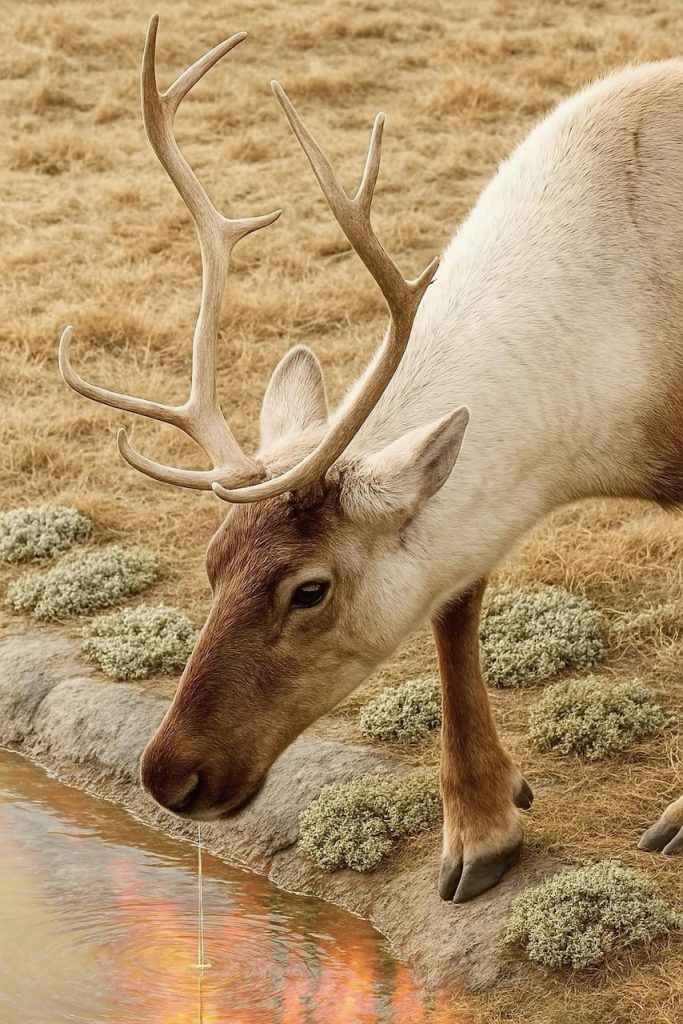Submission 2025
| Submitted by: | Wendy Zou |
| Department: | Renewable Resources |
| Faculty: | Agricultural, Life + Environmental Sciences |
This image captures a boreal woodland caribou (Rangifer tarandus caribou) drinking from a natural pond within Alberta’s boreal forest. The green patches on the ground are ground lichens, which serve as an essential winter food source for caribou. In contrast, the surrounding dry grass highlights the increasing scarcity of available food. The reflection in the water reveals fiery colors, symbolizing the growing impact of climate change and wildfires on vulnerable ecosystems. My research explores how rising temperatures, intensified fire activity, and human disturbances are threatening the habitats that caribou depend on for survival. Using Random Forest modeling and GIS-based spatial analysis, I identify the key ecological and climatic factors influencing lichen distribution and predict future habitat changes under projected 2050s climate scenarios. This image not only reflects the current ecological challenges but also serves as a warning: we risk losing not only the caribou, but also the intricate ecosystems that support biodiversity and human well-being.
Was your image created using Generative AI?
Yes.
Did you upload any materials into an AI tool to help generate your image?
Yes.
Which model of generative AI did you use?
DALL-E 2 by OpenAI, ChatGPT.
How was your image created?
This image was created through a combination of original photography, AI assistance, and manual digital editing. I first captured the photo of a boreal woodland caribou at the Calgary Zoo in Calgary, Alberta. I then used ChatGPT to assist with generating an enhanced version of the caribou photo, adding ground lichens directly onto the landscape to better represent the focus of my research. Separately, I asked ChatGPT to generate an image of a forest wildfire. I manually integrated this wildfire image into the caribou photo by editing the reflection in the pond, symbolizing the increasing threat of climate change to caribou habitats. Final compositing, blending, and color toning were completed using Adobe Photoshop.
How did you craft your prompt to guide the generative AI in creating your image? Please describe the technique or approach you used to convey your vision to the AI.
My goal was to create an image that symbolized the critical relationship between caribou, lichens, and the growing threats of climate change. I wanted to convey both the ecological richness and the fragility of these habitats. To achieve this, I crafted prompts that focused on two key elements. For the ground lichens, I asked the AI to add realistic patches of green lichen onto the forest floor within the original caribou photograph, maintaining a natural and subtle appearance. For the wildfire reflection, I prompted the AI to generate a separate image of an intense forest fire, emphasizing strong, vivid colors to represent environmental disturbance. During the process, I ran multiple generations because some outcomes felt too dark or overly stylized, which did not align with my research vision. As a result, I decided to manually combine the AI-generated elements with my own original photography using Photoshop. This approach ensured that the final image accurately captured both the scientific and emotional aspects of my work without relying solely on AI aesthetic choices.
Please describe what you uploaded to the AI tool, and confirm that the material is your original work, licensed for use (e.g., Creative Commons), used with proper permission.
I uploaded an original photograph I captured myself at the Calgary Zoo, featuring a boreal woodland caribou drinking at a natural pond. The photograph was taken using my personal camera and is entirely my own work, with no inclusion of identifiable people or third-party content. To support my research visualization, I used AI tools to generate ground lichens directly onto the photograph and to create a separate image of a forest wildfire. All AI-generated elements were used to enhance and extend my original work under my direct control.
Where is the image located?
A natural pond within Alberta’s boreal forest.

